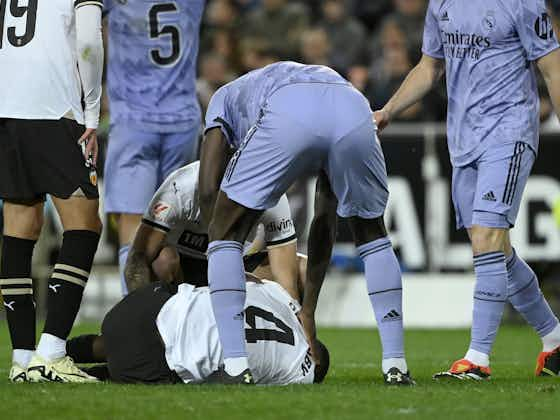Get Spanish Football News
·4 March 2024
‘Risk of not being able to play football again’ – Latest on Valencia star Diakhaby’s knee injury

In partnership with
Yahoo sportsGet Spanish Football News
·4 March 2024

An insight into the extent of the injury suffered by Valencia star Mouctar Diakhaby during his side’s meeting with Real Madrid on Saturday has this evening been provided.
The name of defender Diakhaby of course took its place front and centre in the headlines in Spain this past weekend.
Unfortunately for the 27-year-old, however, this came for less than positive reasons.
Instead, Diakhaby picked up an injury so gruesome that it left both his teammates and opponents in something of a state of shock.
After Aurélien Tchouaméni, completely by accident, fell awkwardly on the planted right leg of Valencia’s defensive stalwart, the serious nature of the situation quickly became evident.
Stretchered from the field of play, Los Che, on Sunday, announced that Diakhaby had suffered a ‘dislocated right knee’:
‘Mouctar Diakhaby has been diagnosed with a dislocated right knee, in tests carried out following Valencia CF’s game at Mestalla against Real Madrid.
‘The centre back remained in hospital overnight and will undergo further tests.’
If the latest word doing the rounds on Monday is anything to go by, however, then the Guinean international’s problem could yet prove to be far, far worse than simply a dislocation.
Speaking in an interview with Cadena SER earlier today, Dr. Enrique Gastaldi – a leading specialist in the field of traumatology – provided an insight into what he diagnoses as a ‘terrifying’ injury:
“The dislocation has taken the anterior cruciate ligament and the posterior cruciate ligament.
“Diakhaby has the most serious knee injury that a footballer can suffer; in injuries like this the first thing to look for is for the patient to be able to walk again.”
And this bleak outlook on the situation was soon echoed by colleague Dr. Juan José López Martínez, who added further context whilst speaking to Estadio Deportivo:
“In a dislocation of this type, it must initially be ruled out that it has vascular involvement, because it can affect the popliteal artery. If so, which I imagine will not have happened in this case, in any hospital they revascularize and that’s it. What follows depends on the amount of damage it has in all the interior structures, but the normal thing is that the meniscus, the two cruciates, and the lateral ligament are affected… The operation is carried out in several phases. First, stability is sought in the corner postero-lateral and the lateral ligament is reconstructed to later do the same with the cruciates. Unfortunately, it is a very serious injury and, therefore, there is a serious risk of not being able to play football again, because they usually damage the cartilage, which is a structure that does not regenerate.”
Conor Laird | GSFN


Live





























































